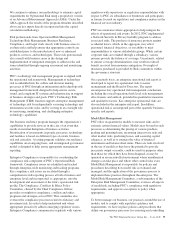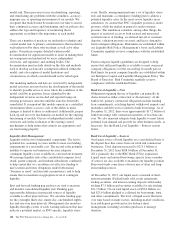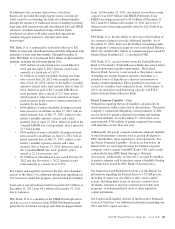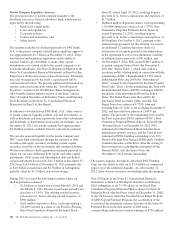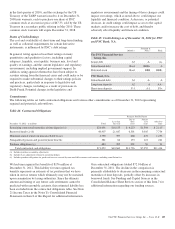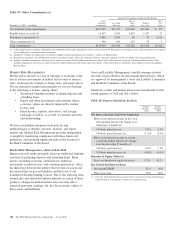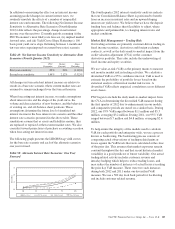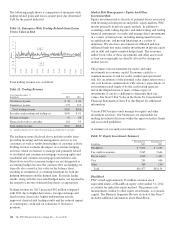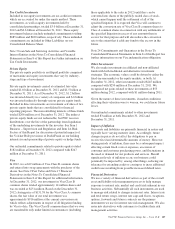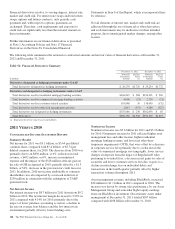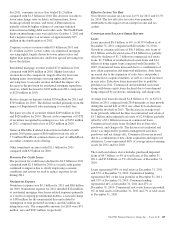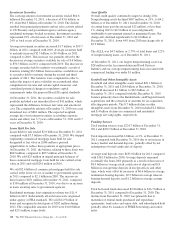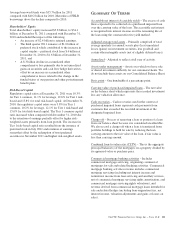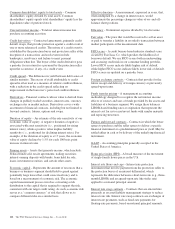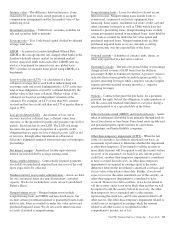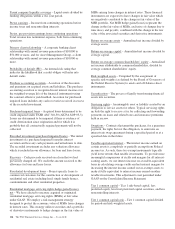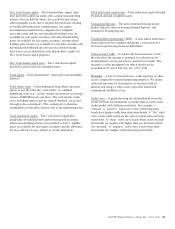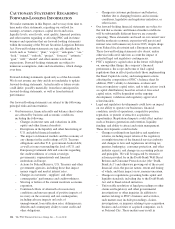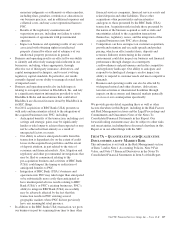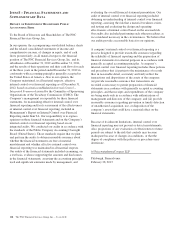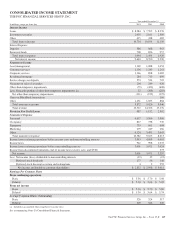PNC Bank 2012 Annual Report Download - page 128
Download and view the complete annual report
Please find page 128 of the 2012 PNC Bank annual report below. You can navigate through the pages in the report by either clicking on the pages listed below, or by using the keyword search tool below to find specific information within the annual report.For 2011, consumer services fees totaled $1.2 billion
compared with $1.3 billion in 2010. The decrease was due to
lower interchange rates on debit card transactions, lower
brokerage related revenue, and lower ATM related fees,
partially offset by higher volumes of customer-initiated
transactions including debit and credit cards. The Dodd-Frank
limits on interchange rates were effective October 1, 2011 and
had a negative impact on revenues of approximately $75
million in the fourth quarter of 2011.
Corporate services revenue totaled $.9 billion in 2011 and
$1.1 billion in 2010. Lower values of commercial mortgage
servicing rights, largely driven by lower interest rates and
higher loan prepayment rates, and lower special servicing fees
drove the decline.
Residential mortgage revenue totaled $713 million in 2011
compared with $699 million in 2010. Higher loan sales
revenue drove the comparison, largely offset by lower net
hedging gains on mortgage servicing rights and lower
servicing fees. Loan sales revenue included the impact of a
decrease in the provision for residential mortgage repurchase
reserves, which decreased to $102 million in 2011 compared
to $120 million in 2010.
Service charges on deposits totaled $534 million for 2011 and
$705 million for 2010. The decline resulted primarily from the
impact of Regulation E rules pertaining to overdraft fees.
Net gains on sales of securities totaled $249 million in 2011
and $426 million for 2010. The net credit component of OTTI
of securities recognized in earnings was a loss of $152 million
in 2011, compared with a loss of $325 million in 2010.
Gains on BlackRock related transactions included a fourth
quarter 2010 pretax gain of $160 million from our sale of
7.5 million BlackRock common shares as part of a BlackRock
secondary common stock offering.
Other noninterest income totaled $1.1 billion for 2011
compared with $.9 billion for 2010.
Provision For Credit Losses
The provision for credit losses declined to $1.2 billion in 2011
compared with $2.5 billion for 2010 as overall credit quality
continued to improve due to slowly improving economic
conditions and actions we took to reduce exposure levels
during 2011.
Noninterest Expense
Noninterest expense was $9.1 billion for 2011 and $8.6 billion
for 2010. Noninterest expense for 2011 included $324 million
of residential mortgage foreclosure-related expenses primarily
as a result of ongoing governmental matters, a noncash charge
of $198 million for the unamortized discount related to
redemption of trust preferred securities, and $42 million for
integration costs. The comparable amounts for 2010 were $71
million, zero and $387 million, respectively.
Effective Income Tax Rate
Our effective income tax rate was 24.5% for 2011 and 25.5%
for 2010. The low effective tax rates were primarily
attributable to the impact of tax-exempt income and tax
credits.
C
ONSOLIDATED
B
ALANCE
S
HEET
R
EVIEW
Loans
Loans increased $8.4 billion, or 6%, to $159.0 billion as of
December 31, 2011 compared with December 31, 2010.
Growth in commercial loans of $10.5 billion, auto loans of
$2.2 billion, and education loans of $.4 billion was partially
offset by declines of $1.7 billion in commercial real estate
loans, $1.5 billion of residential real estate loans and $1.1
billion of home equity loans compared with December 31,
2010. Commercial loans increased due to a combination of
new client acquisition and improved utilization. Auto loans
increased due to the expansion of sales force and product
introduction to acquired markets, as well as overall increases
in auto sales. Education loans increased due to portfolio
purchases in 2011. Commercial and residential real estate
along with home equity loans declined due to loan demand
being outpaced by paydowns, refinancing, and charge-offs.
Average total loans decreased $1.8 billion or 1%, to $152.0
billion, in 2011 compared with 2010 primarily as loan growth
during the second half of 2011 was offset by loan decreases
during the first half of 2011. The decrease in average total
loans primarily reflected declines in commercial real estate of
$3.7 billion and residential real estate of $2.8 billion, partially
offset by a $5.1 billion increase in commercial loans.
Commercial real estate loans declined due to loan sales,
paydowns, and charge-offs. The decrease in residential real
estate was impacted by portfolio management activities,
paydowns and net charge-offs. Commercial loans increased
due to a combination of new client acquisition and improved
utilization. Loans represented 68% of average interest-earning
assets for 2011 and for 2010.
The total loan balance above includes purchased impaired
loans of $6.7 billion, or 4% of total loans, at December 31,
2011, and $7.8 billion, or 5% of total loans, at December 31,
2010.
Loans represented 59% of total assets at December 31, 2011
and 57% at December 31, 2010. Commercial lending
represented 56% of the loan portfolio at December 31, 2011
and 53% at December 31, 2010. Consumer lending
represented 44% at December 31, 2011 and 47% at
December 31, 2010. Commercial real estate loans represented
6% of total assets at December 31, 2011 and 7% of total assets
at December 31, 2010.
The PNC Financial Services Group, Inc. – Form 10-K 109


